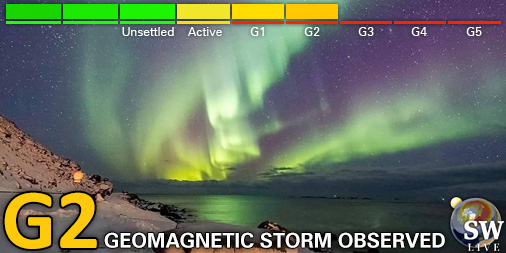Viewing archive of Saturday, 1 July 2017
Daily bulletin on solar and geomagnetic activity from the SIDC
Issued: 2017 Jul 01 1230 UTC
SIDC Forecast
Solar flares
Quiet conditions (<50% probability of C-class flares)
Geomagnetism
Active conditions expected (A>=20 or K=4)
Solar protons
Quiet
| 10cm flux | Ap | |
|---|---|---|
| 01 Jul 2017 | 072 | 009 |
| 02 Jul 2017 | 071 | 008 |
| 03 Jul 2017 | 070 | 023 |
Bulletin
Solar activity was at very low levels during the period. NOAA 2664 was quiet. No earth-directed CMEs were observed in available coronagraphic imagery. The greater than 10MeV proton flux was at nominal levels.
Quiet flaring conditions are expected.
Solar wind parameters were at nominal values until around 18:00UT, when a gradual intensification set in. Bz had a negative stretch around -6 nT from 02:30UT till 05:30UT, then oscillated between -9 and +8 nT (DSCOVR). Wind speed was steady around 340 km/s till 08UT, before gradually increasing to values near 400 km/s. The interplanetary magnetic field was mostly directed away from the Sun. The first of two small negative equatorial coronal holes (CH) has transited the central meridian.
The geomagnetic field was at quiet to unsettled levels, and is expected to remain so. A glancing blow from the 28 June CME is possible late on 2 or on 3 July, likely followed by the particle stream from the small negative CH. This may result in active geomagnetic conditions, with a chance on a minor storming episode.
Today's estimated international sunspot number (ISN): 019, based on 14 stations.Solar indices for 30 Jun 2017
| Wolf number Catania | 011 |
| 10cm solar flux | 072 |
| AK Chambon La Forêt | 011 |
| AK Wingst | 005 |
| Estimated Ap | 004 |
| Estimated international sunspot number | /// - Based on /// stations |
Noticeable events summary
| Day | Begin | Max | End | Loc | Strength | OP | 10cm | Catania/NOAA | Radio burst types | |
|---|---|---|---|---|---|---|---|---|---|---|
| None | ||||||||||
Provided by the Solar Influences Data analysis Center© - SIDC - Processed by SpaceWeatherLive
All times in UTC
Current data suggests there is a moderate possibility for aurora to appear at the following middle latitude regions in the near future
SurgutCurrent data suggests there is a slight possibility for aurora to appear at the following middle latitude regions in the near future
Kazan, Perm, Yakutsk, YekaterinburgLatest news
Latest forum messages
Support SpaceWeatherLive.com!
A lot of people come to SpaceWeatherLive to follow the Sun's activity or if there is aurora to be seen, but with more traffic comes higher server costs. Consider a donation if you enjoy SpaceWeatherLive so we can keep the website online!

Latest alerts
17:00 UTC - Geomagnetic activity
Moderate G2 geomagnetic storm (Kp6) Threshold Reached: 16:34 UTC
15:30 UTC - Geomagnetic activity
Minor G1 geomagnetic storm (Kp5) Threshold Reached: 15:20 UTC
14:30 UTC - Geomagnetic activity
Strong G3 geomagnetic storm (Kp7) Threshold Reached: 14:18 UTC
13:30 UTC - Geomagnetic activity
Moderate G2 geomagnetic storm (Kp6) Threshold Reached: 13:21 UTC
13:18 UTC - Hemispheric Power Index
The OVATION model predicts the Hemispheric Power Index to reach 125GW at 14:01 UTC
Space weather facts
| Last X-flare | 2025/03/28 | X1.1 |
| Last M-flare | 2025/04/15 | M1.2 |
| Last geomagnetic storm | 2025/04/15 | Kp6+ (G2) |
| Spotless days | |
|---|---|
| Last spotless day | 2022/06/08 |
| Monthly mean Sunspot Number | |
|---|---|
| March 2025 | 134.2 -20.4 |
| April 2025 | 124.1 -10.1 |
| Last 30 days | 124.7 -16.6 |






